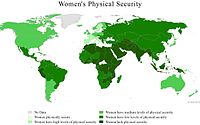This article has multiple issues. Please help improve it or discuss these issues on the talk page . (Learn how and when to remove these messages)
|
Violence against women in New Zealand is described as the kinds of violence disproportionately affecting women compared to men, due to factors of ongoing gender inequality in society. [1] The New Zealand government and justice system view efforts to prevent and deal with violence against women as a priority of New Zealand legislation and the criminal justice system. [2]
Contents
- Incidence of violence against women
- Sexual violence
- Māori women
- Domestic violence
- International Law
- Universal Periodic Review
- Committee on the Elimination of Discrimination against Women
- Organisations
- See also
- References
- External links
Sexual offending costs the New Zealand economy approximately $1.2 billion NZD each year. [3]
